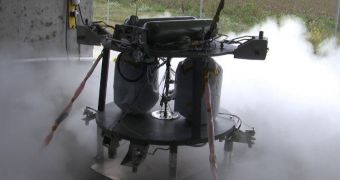The American space agency, in cooperation with a number of university and research centers, is currently developing a sophisticated, free-flying autonomous robotic lander prototype, that would be capable of carrying out complex navigation maneuvers on its own. As part of these efforts, a new type of propulsion system was recently tested.
The development efforts are being conducted at the NASA Marshall Space Flight Center (MSFC), in Huntsville, Alabama. The endeavor is called the Robotic Lunar Lander Development Project.
As part of the initiative, engineering teams recently conducted a series of hot fire tests of a new propulsion system, that is currently awaiting integration in the complicated lander prototype.
MSFC experts are collaborating closely with colleagues at the Johns Hopkins University (JHU) Applied Physics Laboratory (APL), in Laurel, Maryland, for this work. The APL operates under a NASA contract.
The goal of the collaboration is to develop a series of small-scale, versatile and autonomous landers for lunar exploration. These robots need to be capable of carrying out scientific tasks such as installing sensors and collecting samples all on their own.
They need to be able to do so both on the Moon and on near-Earth objects (NEO), such as asteroids and meteorites. For such investigations, mobility is key, hence the need for the advanced propulsion system.
In the new tests, the systems simulated flying in intervals of up to 60 seconds, in a low-gravity environment such as the one on the Moon. The pull of gravity is 6 times weaker on the lunar surface.
According to the timeline NASA developed for this mission, the prototypes lander – featuring the new propulsion system – will begin test flying by the spring of 2011. The tests will be conducted at the US Army's Redstone Arsenal Test Center, also in Huntsville.
“The propulsion hardware acceptance test consisted of a series of tests that verified the performance of each thruster in the propulsion system,” explains expert Julie Bassler.
“The series culminated in a test that characterized the entire system by running a scripted set of thruster firings based on a flight scenario simulation,” adds the official, who is the manager of the Robotic Lunar Lander Development Project.
“This is the second phase of a robotic lander prototype development program,” Bassler adds.
“Our initial 'cold gas' prototype was built, delivered and successfully flight tested at the Marshall Center in a record nine months, providing a physical and tangible demonstration of capabilities related to the critical terminal descent and landing phases for an airless body mission,” she concludes.

 14 DAY TRIAL //
14 DAY TRIAL //